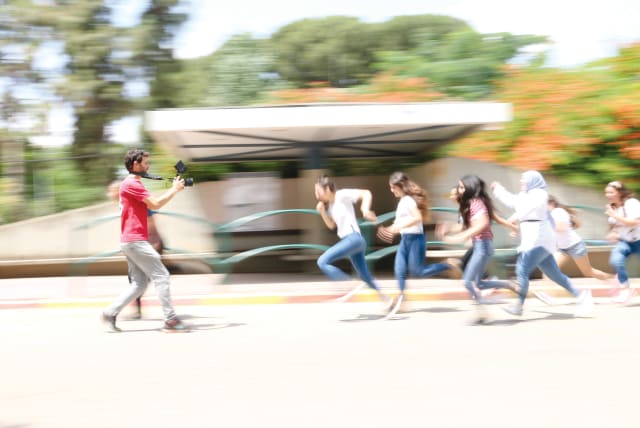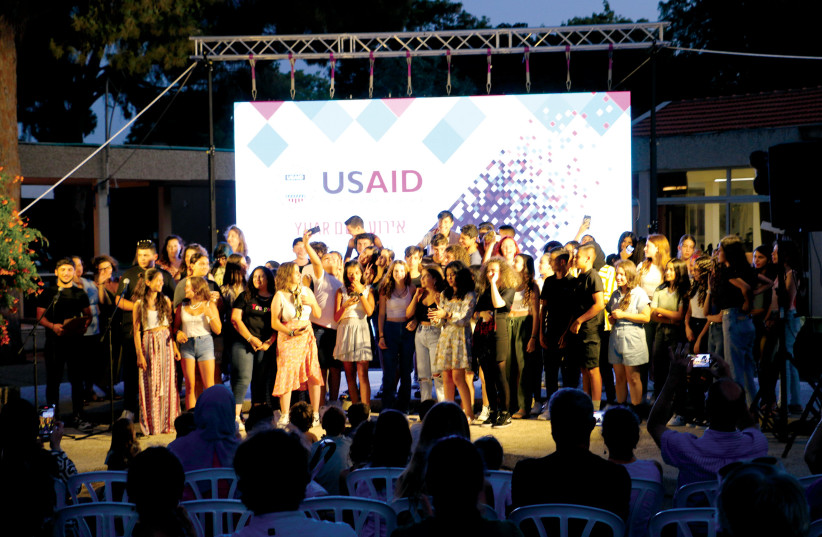Youth United Against Racism brings Israeli Jewish, Arab youth together

The program takes teens – specifically ninth graders – from six Jewish schools and six Arab schools, located in three regional councils.
What do we see in a mirror?
Roots. Mohammed. A placeholder name. Born to a family in Syria during war. Memories? None. After his uncle’s death? None left. They all faded away. Family. Love. She lives with her grandparents. Far away from her parents. Home? Her grandfather is home.
“How is your relationship with your mother?”
“Not so much,” she replies.
Her mother converted to Islam from Judaism when she got married. She doesn’t share anything with her mother. She doesn’t share anything with anyone. Sometimes you hide away your true self to be strong. Transparency. She loves laughing to show people she’s not sad. An evergreen tree. No matter what happens, it stays strong. A butterfly. It’s free. Levitating. Sometimes she wants to be a bird. To fly anywhere she wants to. Where would she fly? She feels she is often trapped at home, while her friends go wherever they want. Emptiness. Heart. Delusion. Fear. A scream. His grandmother’s scream – may Allah keep her safe – when his uncle passed. A scent. Her grandmother. Coming home and smelling her food. The smell of blood in Syria. You can never forget that smell. The smell of life. When you live properly, it’s sweet.
“The truth was a mirror in the hands of God. It fell, and broke into pieces. Everybody took a piece of it, and they looked at it and thought they had the truth.”
You’d be hard-pressed to find words to describe the short video titled Mirror, created by 15-year-old Jewish and Arab youth. This level of emotional openness and cooperation is far too rare a phenomenon, surrounded by the mind-numbing, trend-appealing fog of content looming over the video industry nowadays, the result of companies placing audience retention as their top priority, and many creators growing distant from what the founders of film-making intended it to be.
YUAR: Bringing Arab and Jewish teenagers together
Enter YUAR, or Youth United Against Racism, a program initiated by the Archaeological Museum in Kibbutz Ein Dor in the Lower Galilee, incidentally the first Jewish settlement founded in Israel after the Declaration of Independence. Funded by the United States Agency of International Development (USAID), its goal is to “bring Arab and Jewish teens together” program director Adi Nissenbaum tells The Jerusalem Report.
“The area of the Lower Galilee is a microcosm of Israel. There is a lot of multicultural variety there. It’s not just Jews and Arabs that are mixed, but also Bedouin and fellahin [farm workers],” Nissenbaum says.
The program takes teens – specifically ninth graders – from six Jewish schools and six Arab schools, located in three regional councils, most of which, almost ironically, never come into contact with each other’s communities, despite living in barely a few miles’ radius of each other.
They are unconnected to each other, as if they were twins separated at birth.
“I got to the program thanks to my school,” says student Imri Cirucel, from Adi village. “I found myself in a regional council, surrounded by the Arab community, from living in Kiryat Ata and barely knowing any Arab people, to daily interactions with them. I told myself I have to learn more about the cultures and hear new opinions and perspectives.”
Conversations about the Israeli and Palestinian struggles are never easy. In an age of instantaneous chatter, on an endless journey to find just enough dopamine to keep one going, it is the easiest thing in the world for the younger generation to reduce and simplify the conflict to mere generalizations like “those Jews” or “those Arabs.”
That is exactly why holding these conversations in an honest, open manner and taking true accountability for one’s surroundings is so important.
“Sometimes people don’t really know how the other side is living and what they are suffering from. We were asking each other questions about our struggles and solutions for those struggles. It was surprising for people that they didn’t know a lot of things. They just watched TV but never really knew how things started,” student Yusra Dahleh, from Turan village, tells The Jerusalem Report.
The program has educated and helped develop teens in a variety of ways. Both Yusra and Imri have gained numerous things from attending the program, taking its gifts in their own individual direction.
Yusra says, “The program massively improved my public speaking. It really opened a lot of doors for me to speak more and raise my voice. It reminded all of us that we have a voice, so use it because you’re human, and your voice must be heard.”
Nissenbaum adds, “It is an amazing place for kids to have their voice heard. To be seen. Without any importance to their nationality, only to who they are and their choices.”
The program also aims to influence not only the teens but also their communities. Imri says, “I cannot bring coexistence myself. But I can make the tiniest change by internally understanding that there are people different than me with different points of view and beliefs, getting out of my comfort zone, listening to others, and trying to affect my own small community. If each person were to make that personal change, we would be in a much better place. I would come back immediately every Friday and tell my family about what we learned in the program. People were already asking me ‘What did you learn today?’ That way, I pass it forward.”
Even one of the instructors, Samia Nasser, from Majd al-Krum, found herself in a “teacher becomes the student” situation. She says, “I find myself blooming in these encounters as well.”
She continues, “We all come to these places with preconceptions, stigmas and biases. The heaviest encounter we’ve had followed a series of incidents in the mixed cities between Jews and Arabs. It is not always easy to hear things that go against what you’ve been taught. These encounters allow kids to express themselves without fear of hurting others. People have gotten hurt at times. But we’ve never had an encounter that blew up, and people were always willing to listen. Realizing there are two different narratives and accepting that is already an achievement in and of itself.”
The program incorporates the medium of cinema through every year of activity. It brings in multiple professional directors to create short films alongside the kids
“The mentors give them tools and teach them to create movies, composition, lighting, etc. There are professional conversations about movie making as well. The climax of the film-making part is a seminar where every year we manage to film eight short movies in a single day,” Nissenbaum tells the Report.
As for the short film that I started the article with, Nissenbaum says, “I always tell the director [of Mirror], Shadi Habib Allah, that he’ll step on me on his way to Hollywood. You don’t get to this place of transparency and revealing yourself overnight. It’s a process. They have a safe space to talk. One of the kids is a Syrian refugee; one of them has a mother who converted from Judaism to Islam. People were almost too scared to screen it. And we also had happy-go-lucky films. At the end of the day, they had fun. We can talk about the struggle all we want, they still had fun.”
2022 was the last year for the intended five-year funding program from USAID, in which the students mainly showed the fruits of their labor in their respective schools and passing their messages to their communities. There are still other encounter-based programs in the Ein Dor Archaeological Museum, however, Nissenbaum says. “We are working on a new [funding] request to USAID or to other donors. We want this not for ourselves but because we believe it needs to be done. And we know how to do it. There is still plenty to work on here.” ■
For more information, see https://eindormuseum.co.il/
Jerusalem Post Store
`; document.getElementById("linkPremium").innerHTML = cont; var divWithLink = document.getElementById("premium-link"); if (divWithLink !== null && divWithLink !== 'undefined') { divWithLink.style.border = "solid 1px #cb0f3e"; divWithLink.style.textAlign = "center"; divWithLink.style.marginBottom = "15px"; divWithLink.style.marginTop = "15px"; divWithLink.style.width = "100%"; divWithLink.style.backgroundColor = "#122952"; divWithLink.style.color = "#ffffff"; divWithLink.style.lineHeight = "1.5"; } } (function (v, i) { });

